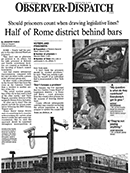Federal Judge strikes down Florida county's prison gerrymander as unconstitutional.
by Aleks Kajstura,
March 21, 2016
On Saturday, in a thorough 86 page opinion, Judge Walker of the United States District Court for the Northern District of Florida struck a blow to prison gerrymandering.
I’ll get to the decision in a minute, but first here’s some background. Each decade, state and local legislative districts are redrawn across the country to ensure that each district contains the same population as other districts. In this way, all residents are given the same access to representation and government. However, the Census Bureau’s practice of counting incarcerated people as residents of the prison location, instead of their home communities, results in significant distortions in achieving fair representation. As Judge Walker put it, “blind reliance on census data can lead to unconstitutional results.”
Over 200 local governments across the US avoid prison gerrymandering by refusing to use Census Bureau data that counts out-of-town people incarcerated there as if they were town residents. But Jefferson County in Florida bucked the trend, preferring to give the residents of District 3 the advantage of sharing their representatives with the disenfranchised people incarcerated in the state’s Jefferson Correctional Institution (JCI).
While all residents of all the other county board districts were harmed by artificially inflating the population of district 3, the prison gerrymandering resulted in particularly harsh impact on the African-American community in the County. The ACLU of Florida and the Florida Justice Institute brought the suit to correct these inequalities.
The judge struck down the prison-gerrymandered redistricting plan and has ordered the county to redistrict based on population data that doesn’t count the people in the state prison as if they were all residents of District 3 (of the 1,157 people incarcerated at JCI, about 9 are Jefferson residents at all). The new plan could allow for a Black influence district in addition to the current Black majority district.
The opinion concludes, summarizing:
Defendants argue vigorously that excluding the JCI inmates from the population base for districting purposes would be “arbitrary.” The opposite is true—including them in the population base is arbitrary. The inmates at JCI, unlike aliens, children, etc. living in Jefferson County, are not meaningfully affected by the decisions of the Boards. To say they are “constituents” of the Board representatives from District 3 is to diminish the term constituent. To treat the inmates the same as actual constituents makes no sense under any theory of one person, one vote, and indeed under any theory of representative democracy. Furthermore, such treatment greatly dilutes the voting and representational strength of denizens in other districts. Jefferson County’s districting scheme for its Board of County Commissioners and School Board therefore violates the Equal Protection Clause. [Citations omitted.]
The opinion is eminently readable; it includes a systematic overview of redistricting case law, including a reminder that none of us technically have a “right to vote”, to a thorough analysis of prisoner-community relations (or lack there of). I promise the 86 pages fly by, you can read it for yourself.
Opinion, Calvin v. Jefferson (March 19, 2016 ). Congratulations to the ACLU and Florida Justice Institute!
And lastly, for anyone wondering about Judge Walker’s approach in relation to Evenwel, he “expresses no opinion” on the relative importance of electoral versus representational equality because prison gerrymandering serves neither goal.
 As we pass the middle of the decade and the Census Bureau is getting ready for the 2020 Census,
As we pass the middle of the decade and the Census Bureau is getting ready for the 2020 Census, 


